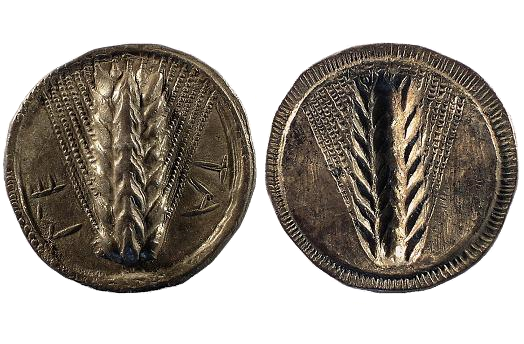
about ancient nomos
Ancient Nomos Art is a museum of galleries exhibiting ancient coins and ancient mint maps. The coin gallery displays the diverse art and history of hand-crafted ancient Greek, Roman, Byzantine, Persian and Medieval coinage. The ancient mints mapping gallery features Greek, Roman, Byzantine, Asia Minor and Medieval mint city regions and territories. Visitor's are welcome to explore, study and enjoy Ancient Nomos Art.

Greek, Lucania – 530 BC
Metapontion
From Ancient Galleries

Obverse: Retrograde ear of barley stalk with seven grains, within a beaded border.
Reverse: Incuse ear of barley stalk, seven grains, within a wide dentilled border.
LEGEND SYMBOLS
Obv. ME-TA, Retrograde ear of barley stalk with seven grains, beaded border. Rev. Incuse ear of barley stalk with six grains, recessed wide dentilled border.
The ancient Magna Grecia city of Metapontion is located along the coastal plains area on the Gulf of Taranto, Italy. Historians believe this city was settled in the early 7th century BC under the leadership of Leukippos and was possibly the first Greek Achaean colony. This primarily agricultural city was situated in a fertile plain flanked by fresh water supplied by the Bradanos and Kasuentos rivers. The ear of barley was perhaps Metapontion’s staple product for food, commerce and trade. The grain undoubtedly signifies the primary motif associated with the cities classical mythology. The god Demeter, said to be the goddess of grain, is known as the city’s revered deity and was perhaps also a part of the cities annual barley harvest celebrations in the Apollo sanctuary at Delphi. The barley emblem on the magnificent coin above became the cities standard nomos coin design by about the mid sixth century BC. A testament to the cities great prosperity is known through the large numbers of these coins found in hoards. The coins of Metapontion and neighboring cities of Kroton and Sybaris share the same features of weight standard, broad and thin plate-like disk flans and incuse reverse types. These coin standards were also minted elsewhere in southern Italy, undoubtedly coordinated to help facilitate commerce, trade and circulation. Evidence of free trade is suggested by the many hoards containing a mixture of coins from other neighboring cities. In addition, southern Italy’s hoard evidence has suggested that these coins were indigenous to south Italy and rarely traveled into neighboring Sicily or greater Magna Grecia. After the end of the sixth century, these uniquely archaic coin types became smaller and thicker throughout south Italy. By the mid fifth century, all coins were eventually replaced by a two sided, relief type design.
SPECIAL FEATURE EXHIBIT
The ANAM Special Features gallery examines the iconic ancient Metapontion coin symbolism depicting a 6-row spike array, non-brittle rachis and bare caryopsis Barley grain. The symbolic Barley image is known today to have resulted from the genetic “zipper” gene mutation. This iconic barley grain Metapontion coin exhibits the atypical hybrid 6-row axial skeletal structural system, which can only be formed vertically by a homeodomain leucine zipper gene mutation. Furthermore and more importantly, this image is clear evidence and proof of plant domestication occurring in Magna-Grecia, circa 530 BC. To view the Special Features Metapontion Barley grain anatomy coin exhibit, please use the following link: Metapontion Nomos Special Feature Exhibit
DOCUMENTATION
Value: Nomos. Metal: AR Silver. Weight: 7.96 grams. Mint: Metapontion. Date: circa 530-500 BC.
Attribution: S. P. Noe 97 (same dies); Sylloge Nummorum Graecorum ANS 203; Historia Numorum Italy 1483; Weber, Plate 30, 736.
Legend, Documentation and Attribution
